Do you have information concerning phonograph cabinet keys not listed here? Email your scans and information to The Old Crank.
Introduction
Phonograph collectors love to finish off their phonograph display with a key in the cabinet lock. The only problem is finding that correct key! The following chart is an attempt to match up the key styles with the cabinets.
Once you find that key, why not show it off? A fellow collector recommends attaching a small tassel to the key. Find a color that compliments the wood in the cabinet. You'll be pleasantly surprised at how nice it looks!
Now, on to the keys...

|
|
|
| Antique brass finish, this key seems to include decorative letters "A V" in the handle. The end of the shaft is triangular, similar to the Cheney (photo courtesy of Bob Johnson). |
 |
|
|
|
 |
Gold plated, part number 34. 1925 price - 25¢ (reference: Brunswick Phonograph and Motor Parts catalog, July 1, 1925). |
| Nickel plated, part number 38. 1925 price - 15¢ (reference: Brunswick Phonograph and Motor Parts catalog, July 1, 1925). |  |
 |
Model 101 portable, part number 56. 1925 price - 5¢ (reference: Brunswick Phonograph and Motor Parts catalog, July 1, 1925). |
| Variations
The first key shows a hint of its original nickel plating and measures 2 1/4 inches in length. |
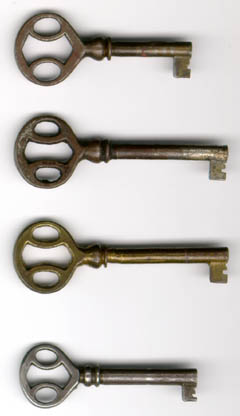 |
| The second key also shows a bit of its original nickel plating, but is a bit longer at 2 5/8 inches. | |
| The third key is 2 5/8 inches long and gold plated. | |
| The fourth key is 2 1/4 inches in length, and has a slightly different handle and design on the barrel. | |
|
|
|
  |
Nickel and antique brass finish keys. The end of the shaft is triangular. |
|
|
|
  |
"C" key. This key was available in both nickel and gold (gold key photo courtesy of Ken Ogden). |
| This "X" key also reportedly fits certain Columbia cabinets. (photo courtesy of Ken Ogden). |
 |
|
|
|
 |
Edison key with two ram heads. This key was used with higher-priced Edison Disc Phonographs like the 290, 375, 425, and 450. (Information courtesy Ron Dethlefson, photo courtesy Bob Johnson). |
 |
"Dolphin" key similar to the Sonora style, apparently used with some versions of the Amberola 1A. It has a flat bit and is stamped Eagle Lock Co USA Terryville, CT (information and photo courtesy Michael Christiaens). |
| "Dolphin" key. This style came in at least seven different sizes, ranging from about 2 to 4 inches in length (Information courtesy of Leslie Rosenfeld). There is another Edison key with two rams butting heads. This key was used with higher-priced Edison Disc Phonographs like the A290, 375 and 425 (Information courtesy Ron Dethlefson). |  |
 |
Another "Dolphin" key. This one has a different tooth, with only one groove. This key fits the A/B/C-250 (Information and photo courtesy Dave White). |
| "E" key (Photo courtesy Dave White). |  |
 |
Edison also used the Brunswick-style keys for the model A Disc Phonographs (A250 and lower; information courtesy Ron Dethlefson). |
|
|
|
| "Dolphin" key. There are subtle differences between the Sonora and Edison dolphin-style keys (photo courtesy of Bob Johnson). |  |
|
|
|
  |
Gold plated Pooley VTLA Victrola cabinet keys. This cabinet required two keys. The top key is for the lid lock. The bottom key opens the access door on the rear of the cabinet. |
| Gold plated "old" style Victrola & Auxetophone, part number 1179GP. 1910 price - 50¢ Also, part number 1179PF 1910 price - 40¢ (reference: Catalog of Repair Parts for Victor Talking Machines, April 1, 1910. Photo courtesy of Steve Andersen). |  |
 |
Gold plated "new" style Victrola & Auxetophone, part number 1465GP; 1910 price - 50¢ Also, part number 1465PF 1910 price - 40¢ (reference: Catalog of Repair Parts for Victor Talking Machines, April 1, 1910). |
| Nickel plated "new" style Victrola, part number 1465PF. Probably available in this finish as of September 1910. |  |
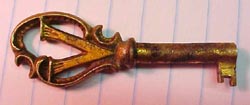 |
This is an interesting variation of the gold plated "V" key. (Photo courtesy of George Vollema). |
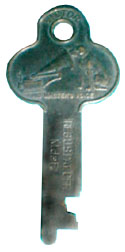 |
Another interesting Victor key. Although it's hard to see, there is a raised Victor logo on this flat key with the word "Victor" over the key chain hole. Initial research indicates that this may be the standard Victor cabinet key from about 1924. One version of the VV-100 uses this key (Photo courtesy of Dennis Back). |
| This unusual Victrola key was found in an art model Chinese Chipendale (photo courtesy of Bob Johnson). |  |
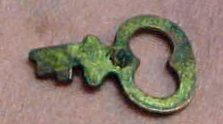 |
This small key fits the Victrola Orthophonic portable model 2-55 and dates to 1929. |
| This really isn't a cabinet key, but I thought it interesting enough to include in this chart. This is a firebox key from the Victor factory building. Note the "VTM" mark. |
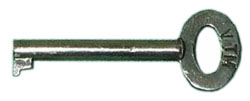 |